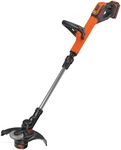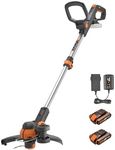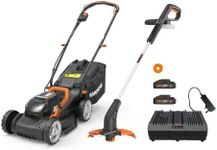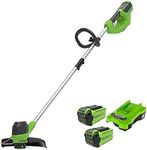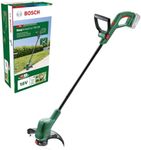Buying Guide for the Best String Trimmers
Choosing the right string trimmer can make yard maintenance much easier and more efficient. A string trimmer, also known as a weed eater or weed whacker, is a versatile tool used to trim grass and weeds in areas that a lawn mower can't reach. To find the best fit for your needs, consider the following key specifications and how they align with your yard's requirements and your personal preferences.Power SourceString trimmers can be powered by gas, electricity (corded), or batteries (cordless). Gas-powered trimmers are typically the most powerful and are suitable for large yards or heavy-duty tasks. However, they are also louder and require more maintenance. Corded electric trimmers are lighter and quieter, making them ideal for small to medium-sized yards with easy access to power outlets. Cordless battery-powered trimmers offer the convenience of mobility without the need for a power cord, but their runtime is limited by battery life. Choose a power source based on the size of your yard and the type of trimming you need to do.
Cutting WidthThe cutting width of a string trimmer refers to the diameter of the area it can cut in a single pass. This spec is important because it affects how quickly you can complete your trimming tasks. Cutting widths typically range from 10 to 18 inches. A larger cutting width means you can cover more ground faster, which is beneficial for larger yards. However, a smaller cutting width offers more precision and is easier to maneuver in tight spaces. Consider the size of your yard and the level of detail required when choosing the cutting width.
WeightThe weight of a string trimmer can impact how comfortable it is to use, especially for extended periods. Lighter trimmers are easier to handle and reduce fatigue, making them a good choice for smaller yards or for users who may not have a lot of upper body strength. Heavier trimmers, often gas-powered, may offer more power but can be more tiring to use. Think about how long you will be using the trimmer and your physical comfort when selecting the weight.
Shaft TypeString trimmers come with either a straight or curved shaft. Straight shaft trimmers are generally longer and provide better reach, making them suitable for trimming under bushes and around obstacles. They are also more comfortable for taller users. Curved shaft trimmers are shorter and lighter, offering better balance and ease of use for shorter users or for trimming in open areas. Choose a shaft type based on your height and the specific areas you need to trim.
Line Feed SystemThe line feed system determines how the trimmer line is advanced during use. There are three main types: bump feed, automatic feed, and fixed line. Bump feed systems require you to tap the trimmer head on the ground to release more line, giving you control over the line length. Automatic feed systems release line as needed without any user intervention, offering convenience but potentially wasting line. Fixed line systems use pre-cut lengths of line that you manually replace, which can be more durable but less convenient. Consider how much control and convenience you want when choosing a line feed system.
Noise LevelThe noise level of a string trimmer can be an important consideration, especially if you live in a neighborhood with noise restrictions or if you prefer a quieter operation. Gas-powered trimmers are generally the loudest, while electric and battery-powered trimmers are quieter. If noise is a concern, look for trimmers with lower decibel ratings or consider electric or battery-powered models. Think about your environment and personal preference for noise when making your choice.
